Early Filmmakers
1 Hinatsu Eitaro=Huh Young
A filmmaker with three names—Hinatsu Eitaro in Japan, Huh Young in Korea, and Huyung in Indonesia—is known as the director of the lost film You and I (1941). Presented here is a retrospective look at a filmmaker who was a victim of his time.
A Filmmaker with Three Names
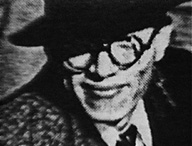 (“Syegeui irumul gajin yonhgfwain”)
(“Syegeui irumul gajin yonhgfwain”)- SOUTH KOREA / 1997 / Korean / Color / Video / 55 min
Director: Kim Jae-bum
Script: Lee Jong-whan
Photography: Chang Jong-sul, Kang Dong-geol, Kim Kyung-nam, Min Byung-il
Editing: Yoo Kyung-sang, Cha Jong-hoon
Music: Choi Jung-yoon
Production Company: Shin Dong A Panavision
The filmmaker Huh Young was born in colonial Korea. Taking the name Hinatsu Eitaro, he became an active member of the Japanese film world and returned to the colony directing the “Japan and Korea as One (naisen ittai)” propaganda film You and I (1941). Later, journeying to Indonesia with the military, he became deeply involved in the movement for Indonesian independence, using film as a weapon. Traces of the difficulties of a life spent protecting three separate identities are recorded in Huh Young’s cinematic works.
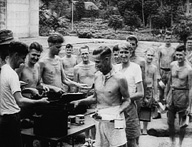 Nippon Presents (a.k.a. Nippon Calls)
Nippon Presents (a.k.a. Nippon Calls)
- THE NETHERLANDS / 1945 / English / B&W / Video (Original: 35mm) / 36 min
Director: Jaap Speyer
Editing: Peggy Graham Scott
Producer: Frederick Daniell
Production Committee: Netherlands Indies Government Film Unit
Production Cooperation: The A.M.F., The R.A.A.F., The R.A.F., The R.A.N., The Royal Netherlands Army, The Prisoners of War Relatives Association
Source: Yamagata Documentary Film Library
The original POW Presents, Calling Australia was filmed by the 16th Branch of the General Staff of Japan and directed by Huh Young, a Korean known in Japan as Hinatsu Eitaro. This propaganda film shows how Australian POWs were enjoying a comfortable life in Japanese detention camps. Needless to say, the real life of POWs was far removed from the film’s representation. After the surrender of Japan, the Allied Forces seized POW Presents, Calling Australia and re-edited it into Nippon Presents, adding interviews with POWs in order to show the cruel treatment of POWs at the hands of the Japanese army.
2 Kanai Seiichi = Kim Hak-seong
Made under Japanese colonial rule, the recently discovered Homeless Angel (1941) caused a stir in South Korea. Kanai Seiichi = Kim Hak-seong photographed this film. In Korea, he shot An Aimless Bullet (1961) and Arirang (1968) among other films.
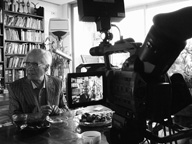 The Man with Two Names: Cameraman Kim Hak-seong, Kanai Seiichi
The Man with Two Names: Cameraman Kim Hak-seong, Kanai Seiichi
(“Futatsu no namae o motsu otoko: Kyameraman Kimu Hakuson, Kanai Seiichi no sokuseki”)- JAPAN / 2005 / Japanese, Korean / Color / Video / 81 min
Director: Tanaka Fumihito
Photography: Nagata Yuichi
Source: Tanaka Fumihito
Master cameraman Kim Hak-seong, who left his mark on Korean film history with works such as An Aimless Bullet (1961) directed by Yu Hyeon-mok, was a cinematographer in pre-war Japan working under the name Kanai Seiichi before returning to Korea. In the burgeoning Korean film world, he made a significant contribution to the development of Korean cinema. Using the testimony both of contemporary Korean film’s leading figures, whom he had fostered, and of family members, this film traces the life of this great cameraman with two names.
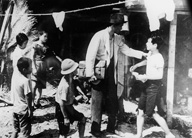 Homeless Angel
Homeless Angel
(“Jib-eobsneun cheonsa”)- KOREA / 1941 / Korean, Japanese / B&W / 35mm / 73 min / Japanese subtitled version
Director: Choi In-kyu
Original Story, Script: Nishiki Motosada
Photography: Kanai Seiichi
Editing: Lee Ik
Sound: Yang Joo-nam
Music: Ito Senji, Kim Jun-young
Art Director: Kim Jeong-hang
Lighting: Choi Jin
Cast: Kim Il-hae, Moon Yae-bong, Hong Eun-sun, Kim Sin-jae
Planning: Kim Jeong-hyeok
Producer: Lee Chang-yong
Production Company: Koryo Film Association
Distributor: Towa Shoji
Source: Korean Film Archive
Along with such works as Military Train (1938) and Volunteer (1941), this film is one of four Korean feature films made in the Japanese colonial era which were discovered in China by the Korean Film Archive. They were shown at the 6th Jeonju International Film Festival this year amid great interest. This film is based on the true story of a pastor who tried hard to help the street children thronging the streets of Keijo (Kyeong Seong, now Seoul)—a social problem at the time, and started a program to educate them. He struggles to take care of the children at the Hyang Rin Won boys’ orphanage on a farm on the outskirts of the city. Consistent with the mood of the day as expressed in the slogans “Japan and Korea as One (naisen ittai)” and “Film is Patriotic (eiga hokoku),” this film was also shown in Japan.
3 Inoue Kan = Lee Byoung-woo
With his sights set on filmmaking, Inoue Kan = Lee Byoung-woo traveled to Japan and worked as a cinematographer at Prokino under the name Arashi Genkai. He is, in part, responsible for Snow Country (dir. Ishimoto Tokichi), considered to be the origin of Japanese documentary filmmaking, and the beautiful aerial photography of Young Flying Corps. His skill as a photographer can also be seen in films directed by Shin Sang-ok and Kim Su-yong in Korea.
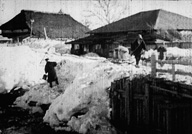 YIDFF Opening Screening
YIDFF Opening Screening
Snow Country
(“Yukiguni”)- JAPAN / 1939 / Japanese / B&W / 16mm / 38 min
Director: Ishimoto Tokichi
Photography: Hashimoto Tatsuo, Inoue Kan, Ryujin Takamasa, Kurose Susumu, Narita Tsutomu
Line Producer: Koyama Yoshio
Supervisors: Japanese Society of Snow and Ice, The Japan Folk Craft Association
Producer: Omura Einosuke
Production Company: Geijutsu Eigasha
Source: City of Shinjo Snow Village Information Office
Omura Einosuke and Ishimoto Tokichi, who were influenced by Paul Rotha’s Documentary Film, set up Geijutsu Eigasha with many talented filmmakers such as Inoue Kan from Prokino. Ogawa Shinsuke said that he often heard about Snow Country from Ishimoto Tokichi. Ishimoto spent three long years shooting in Shinjo, Yamagata, which is an area with heavy snowfall, and made an independent, authentic documentary depicting the farmers’ life of struggle against the snow. It is no exaggeration to say that this film is the starting point of Japanese documentary film.
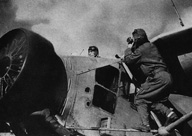 Young Flying Corps
Young Flying Corps
(“Sora no shonenhei”)- JAPAN / 1941 / Japanese / B&W / 35mm / 37 min
Photography, Editing: Inoue Kan
Original Story: Okabe Shinji, Koyama Yoshio
Assistants: Kurose Kin, Goto Shuji
Supported by: Naval Ministry
Production Company: Geijutsu Eigasha
Source: Seido Film Productions, National Film Center
Following their dreams of becoming naval fighter pilots, boys come from all over Japan to join the Kasumigaura Naval Aviation Corps. After rigorous ground training, they practice solo flying and then formation flying before earning their wings and leaving for their respective squadrons. Inoue Kan’s death-defying aerial photography was worth it; the film was a critical success. In Inoue’s capable hands, the film rises above mere propaganda, vividly capturing the lives of boys going off to war.
4 Ube Takashi = Kim Sun-myoung
Ube Takashi = Kim Sun-myoung made his mark on film history as the producer of such films as Children of the Base and Children of Korea. Making a significant contribution to the production of Japanese documentary film in the post-war era, he is remembered as one of the filmmakers who repatriated to North Korea.
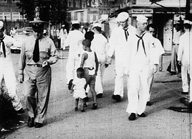 Children of the Base
Children of the Base
(“Kichi no kotachi”)- JAPAN / 1953 / Japanese / B&W / 16mm / 29 min
Editing: Kamei Fumio, Tanaka Toru, Tomizawa Takao, Jinbo Harue, Yamazaki Seikyo
Photography: Inoue Kan, Ushiyama Kunikazu, Yamagata Shu, Segawa Hiroshi, Sakazume Yasuo
Sound: Katayama Mikio
Music: Hara Taro
Lighting: Tanaka Mitsugoro, Suzuki Sadao
Producers: Saito Mika, Ube Takashi
Production Company: Tokyo Kino Productions
Source: Japan Document Film
“Japanese Entry Prohibited” read the fences of the ever-increasing U.S. military bases. Over 700 in number and encompassing an area rivaling the island of Shikoku, these bases encroached upon the lives of the children of Japan. A northern base in Chitose, Hokkaido; a base in the mountain village of Tozawa in Yamagata Prefecture; urban bases in Yokosuka and Tachikawa as well as Uchinada in Ishikawa Prefecture. The current situations surrounding these bases are depicted from the perspectives of the children outside their gates. Produced by Kim Sun-myoung’s Tokyo Kino Productions, the film is directed by Kamei Fumio and filmed by Inoue Kan among others. About Tokyo Kino Productions, B camera unit leader Kikuchi (Yamagata) Shu recalls, “They had nothing, just a desk.”
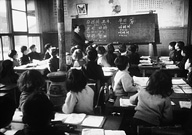 Children of Korea
Children of Korea
(“Chosen no ko”)- JAPAN / 1955 / Japanese, Korean / B&W / 35mm / 30 min
Directors: Arai Hideo, Kyogoku Takahide
Script: Kyogoku Takahide, Yoshimi Yutaka, Arai Hideo, Maruyama Shoji, Korean Filmmakers’ Collective
Photography: Okojima Yoshikazu, Shimizu Hiroshi
Editing: Iwasa Hisae, Morizui Fusako, Yasuda Misako
Sound: Katayama Mikio, Oya Tadao
Music: Nagasawa Katsutoshi, Choi Dong-ok
Lighting: Asami Ryoji, Yasuda Isaburo,
Producers: Lee Hung-yol, Nam Il-yong, Nam Man-sik, Kim Sun-myoung, An Rak-jin, Chun Chi-o, Kang Yong-kun
Production Committee: National PTA of Zainichi Korean Schools, Zainichi Korean Teachers’ League, Zainichi Korean Filmmakers’ Collective
Source: Chongryon Film Studio
In 1952, the Tokyo Metropolitan Government Board of Education unilaterally declared that “all metropolitan Korean schools will close as of March 31, 1956.” In protest, fellow zainichi organized the Children of Korea Production Committee to save “ethnic education,” and produced this film together with Kim Sun-myoung and other members of the Korean Filmmakers’ Collective. Based on compositions by students at the time and including scenes of an old Korean woman from Kobe vividly recounting the many hardships she endured before the war, this film teaches us about the history of a people whose lives were shaped by discrimination and oppression.
